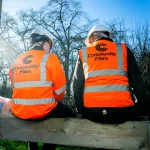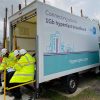Study Shows Benefits of 5G and Full Fibre to UK Local Authorities
A new piece of research from Oxera, which was commissioned by the Broadband Stakeholder Group think-tank, has helped to highlight some of the benefits (better employment, increased economic activity etc.) that UK Local Authorities could expect if they help to rollout 5G mobile and “full fibre” broadband.
At present it’s quite well known that the different approaches to street works, permits and planning permission – among other things – that exist between local authorities can sometimes make it more difficult for operators to rollout fibre optic (FTTP) broadband ISP networks (examples here and here). Resolving this will be vital if the UK is to stand any chance to meeting the Prime Minister’s full fibre for all pledge by 2025 (here).
Similarly mobile network operators have long called (example) for better access to public sector assets (e.g. street furniture, buildings), more flexibility in planning and generally better collaboration from local authorities to help achieve the Government’s aim for 95% geographic 4G mobile coverage by 2022. As well as to support the latest ultrafast 5G technology, which will hopefully reach the majority of the population by 2027.
Advertisement
In order to support this the new report has attempted to set out a framework, with six different stylised areas, with which to highlight how local authorities can understand what sort of economic benefits might be generated by these new services for their locality. The benefits are often both indirect (e.g. a more vibrant and attractive business environment) and direct (e.g. cost savings on new connectivity) to the authority.
Summary of Potential Benefits
Benefits for existing businesses
Existing businesses can expect to benefit from business expansion, improved productivity and greater turnover, as a result of improved access to existing markets, entry into new markets enabled though improved communication and distribution channels, and the ability to offer innovative new services.
The evidence shows that, on average, existing businesses will see increased productivity, with an expected impact of between 0.3% and 3.8% increase in turnover per worker per annum.
New businesses
Significantly improved connectivity can encourage new business start-ups, enabled by easier access to markets, lower barriers to entry and the development of new business models that are digitally dependent and more flexible than established businesses.
At a local level, if speeds are higher relative to other surrounding areas (or similar, competing areas), new or established businesses may also be attracted into the area from elsewhere, thereby boosting the level of business activity in the local area.
The evidence shows an expected impact of between 0.4% and 3.2% increase in the number of businesses operating in the area.
Improved employment opportunities
Evidence shows that improved broadband speeds and greater penetration of fibre in an area will lead to increased participation in the labour market and higher employment levels linked to the creation of new jobs.
Furthermore, as a result of improved communication channels and opportunities for remote working, there will be new employment opportunities or a reduction in migration away from the area that might otherwise have been at a disadvantage in terms of broadband availability/speeds (this is referred to as ‘safeguarding jobs’).
The evidence shows that there could be an increase in employment in the area (new jobs, inward migration and safeguarded jobs) of around 0.6–1.7%.
Private benefits to consumers
There will be private consumer benefits in terms of access to a greater number of services. These benefits will be reflected in increased consumer surplus, i.e. the difference between willingness to pay (value) and the actual price. Consumer surplus will increase where price declines as a result of increased competition and/or willingness to pay rises as a result of increased connectivity and enables access to new and valuable services.
Consumers may also experience improvements in subjective personal wellbeing, for example from the greater range of entertainment or education options or increased social inclusion.
Benefits to LAs
At the local level, public service providers, such as LAs, could benefit from cost savings in the delivery of public services and benefits associated with the improved economic environment.
Increased economic activity can have a number of benefits for a local area, both directly through some additional income (for example through business rates) and indirectly (through assisting with a range of other LA objectives facilitated by increased economic activity such as reduction in antisocial behaviour or deprivation).
There is also a significant ‘option value’ associated with deploying physical infrastructure that is ‘future-proof’, thereby reducing the costs associated with civil engineering in the long run and the trialling of new services in a more cost-effective way.
Benefits to wider society
Wider society may benefit through network externalities, or positive spill-overs. As more people are connected, further developments have a greater impact, and benefits might also accrue more widely than just to the subscribers and producers of such services. This could also deliver important, but often unquantifiable, social benefits such as greater social inclusion.
The report caveats that these impacts and outcomes “will not apply uniformly across all local area types … there will be differences in the impacts and outcomes depending on the specific characteristics of the area.” Likewise it notes that, for 5G in particular, they don’t yet have the experiences to always put an accurate figure against it (likely to be refined once the 5G rollout is more established).
We should add that the Government’s Barrier Busting Taskforce, investment/voucher schemes, business rates relief, Future Telecoms Infrastructure Review (FTIR) – including related changes from Ofcom – and their recent proposals to soften the planning rules for mobile networks (here), have already gone some way to improving the environment.
However local authorities must also remain mindful of their constituents and there are thus some areas where they will clash with the desire for positive technological change, particularly if it risks upsetting voters. One recent example of this stems from the National Association of Local Councils (NALC), which has voiced opposition to calls for greater flexibility in planning permission for new mobile masts (here).
Advertisement
BSG – LA Impact of Full Fibre and 5G (PDF)
http://www.broadbanduk.org/Impact-of-full-fibre-and-5G.pdf
Mark is a professional technology writer, IT consultant and computer engineer from Dorset (England), he also founded ISPreview in 1999 and enjoys analysing the latest telecoms and broadband developments. Find me on X (Twitter), Mastodon, Facebook, BlueSky, Threads.net and Linkedin.
« Devon and Somerset UK Scrap Gigaclear FTTP Broadband Contract
O2 UK Launches Unlimited 4G Mobile Broadband Data Plans »


















































Comments are closed